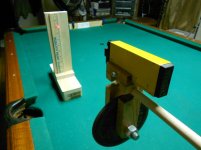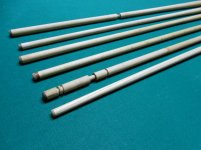When the CB is struck offcenter it rotates while the tip is in contact with it, pushing the tip aside in one direction and itself (the CB) aside in the opposite direction. The CB pushing itself aside is squirt.
Imagine yourself and another person standing on roller skates facing each other. If you push that person in the chest you'll both roll backwards away from each other (the same "opposite reaction" we see with the CB and tip). If he's small and light, he'll go farther than you will - but if he's big and heavy you'll go farther. In the same way, a heavier tip resists the CB's push more, causing the CB to push itself farther aside (producing more squirt).
Why "end mass"? Because of the speed that the "shock waves" travel along the shaft when it hits the CB, only the weight (mass) of the first several inches of the shaft are "felt" by the CB.
pj
chgo
He is right here guys. Also the stiffer shaft is like the heavy guy. The stiff shaft does not want to move so it shoves the cue ball. The cue ball has no support so it squirts.



